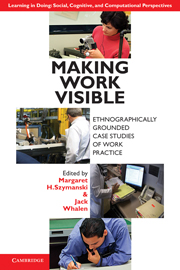Book contents
- Frontmatter
- Contents
- List of Figures and Excerpts
- List of Tables
- List of Contributors
- Series Foreword
- Foreword by John Seely Brown
- Acknowledgments
- Introduction
- Part I Work Practice Study in Historical Context
- 1 Work Practice and Technology
- 2 Engineering Investigations
- Part II Applying Work Practice Methods
- Part III Practices around Documents
- Part IV The Customer Front
- Part V Learning and Knowledge Sharing
- Part VI Competency Transfer
- References
- Index
- LEARNING IN DOING: SOCIAL, COGNITIVE AND COMPUTATIONAL PERSPECTIVES
2 - Engineering Investigations
What Is Made Visible in Making Work Visible?
Published online by Cambridge University Press: 05 August 2012
- Frontmatter
- Contents
- List of Figures and Excerpts
- List of Tables
- List of Contributors
- Series Foreword
- Foreword by John Seely Brown
- Acknowledgments
- Introduction
- Part I Work Practice Study in Historical Context
- 1 Work Practice and Technology
- 2 Engineering Investigations
- Part II Applying Work Practice Methods
- Part III Practices around Documents
- Part IV The Customer Front
- Part V Learning and Knowledge Sharing
- Part VI Competency Transfer
- References
- Index
- LEARNING IN DOING: SOCIAL, COGNITIVE AND COMPUTATIONAL PERSPECTIVES
Summary
Introduction
“Work” has been a long-standing topic for a number of disciplines. One of the “founding fathers” of economics, Adam Smith, developed the concept of the “division of labour,” the idea of optimising the organisation of work in mass production. In philosophy, Karl Marx, in part, defines what it is to be human by our need to work on our environment. In psychology, the subdiscipline of ergonomics was developed in order to better design the fit between the physical and psychological needs of individuals; the organisation of the workplace, equipment, and machinery; and the job itself, by measuring working performance. However, it is within sociology that work has assumed a particularly central role. Not only does it play out across the discipline's major theories, it has become a subdiscipline in its own right: “the sociology of work.”
Despite this wide and diverse interest in work across a range of disciplines, and particularly in sociology, Xerox's interest in studying people doing work, in the midst of them actually doing it (which is what has become known as work practice studies), has been mainly centred around a relatively small branch of sociology, ethnomethodological studies of work, initially developed by Harold Garfinkel (1967).
- Type
- Chapter
- Information
- Making Work VisibleEthnographically Grounded Case Studies of Work Practice, pp. 34 - 50Publisher: Cambridge University PressPrint publication year: 2011
- 3
- Cited by

